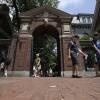In only a matter of weeks, the Ice Bucket Challenge raised a windfall. 220-million dollars for a disease many had never heard of, ALS.
Steve Perrin runs the “ALS Therapy Development Institute” in Cambridge. Ice Bucket Money is like a turbo-charge. This one lab, among many worldwide, received four million dollars and it’s allowed researchers here to fund, in a matter of months, two new drugs for human testing.
“The two drugs we’ve funded probably wouldn’t have been ready for clinicial development for two to three more years,” said Perrin.
This lab is also using Ice Bucket Money to expand a program that tests patient skin cells in hopes of identifying different types of ALS. “The more data we have to understand and stratify and classify patients, the more successful we’re going to be in getting the right drug to the right group of patients,” said Perrin.
Originally capped at 25 patients, the program will now include 300, among them, Mike Wesolowski. “I have what seems to be a slowly progressing variant, at least so far we can tell,” said Wesolowski.
Mike and his wife, Jenn, were on vacation last summer in Portugal. It was the height of the Ice Bucket Challenge craze, but ALS was the last thing on Mike’s mind when, as he was climbing this castle wall, his body began to give out. In January, doctors diagnosed ALS.
“We would go out for dinner sometimes and our conversations would turn into tears,” said Jenn.
Mike is doing everything he can to stay positive. But the thing that has been most empowering is being part of the research. Mike has high hopes for the information his skin sample will yield. “That it will really bring more understanding on molecular level, what’s causing this and what can be done to slow it or stop it,” said Wesolowski. “It’s exciting.”
And, for Mike and Jenn, that may be the most tangible outcome of the Ice Bucket Challenge, a sense that a viral sensation is fueling scientific momentum.




